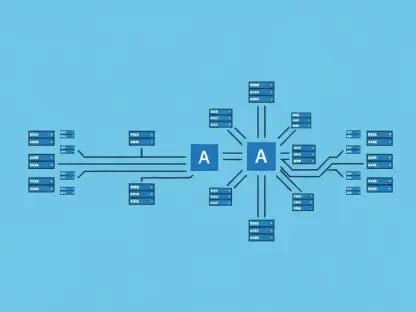In the ever-evolving world of web development, CSS has transitioned from a rudimentary presentational language to a more complex tool incorporating logical capabilities. With this transformation come challenges and opportunities, engaging experts like Vijay Raina in meaningful discussions about its future. As an authority on software design and architecture, Raina offers valuable insights into this pivotal shift in web development.
How has CSS evolved from being a purely presentational language to one with logical powers?
CSS started as a language purely for styling purposes—dictating the visual appearance of web pages. Initially, it was segregated from HTML content and JavaScript-based logic, making it a straightforward yet limited tool for developers. Over time, however, advancements like container queries, relational pseudo-classes, and new functions such as if(), have infused CSS with logical operations. These enhancements have pushed CSS into a more imperative domain traditionally handled by JavaScript, enabling CSS to respond and adapt more dynamically to user interactions and environmental contexts.
What were the original purposes of CSS when it was first proposed by Håkon Wium Lie?
CSS, when first proposed by Håkon Wium Lie in 1994, was intended to separate content from presentation. Its initial purpose was to make web page styling more manageable by handling aspects such as fonts, colors, layout, and spacing. By decoupling presentation from the HTML content, maintenance became simpler, which was vital for the early web as it grew in complexity and scale.
What are some of the recent advancements in CSS that have contributed to its shift towards an imperative paradigm?
In recent years, CSS has integrated new features allowing it to handle more complex styles and conditional logic, which shifts it towards an imperative paradigm. Notable advancements include container queries, which adapt styles based on the container’s dimensions, and relational pseudo-classes, which allow CSS to style elements in relation to their structure. These have collectively enhanced CSS’s capacity to create responsive and interactive web designs, traditionally the domain of JavaScript.
How do features like Flexbox, CSS Grid, and media queries contribute to making CSS more context-aware?
These features are pivotal to the development of context-aware CSS. Flexbox and CSS Grid have revolutionized layout design, making complex alignments and positioning simpler and less reliant on legacy practices like floats or tables for layouts. Media queries introduced that dynamic capability to adapt styles based on device characteristics, such as screen size or orientation, thus enabling designs that adjust fluidly to different environments. These improvements mark a shift to a more dynamic and user-responsive CSS that can apply styles based on the surrounding context.
How has CSS been encroaching on JavaScript’s traditional role in handling interactivity and logic?
CSS is traditionally admired for its styling capabilities, leaving logic and interactivity largely to JavaScript. However, with features like container queries and the if() function, CSS is encroaching on JavaScript’s territory. For instance, tasks that were once strictly the domain of JavaScript, such as creating interactive elements like accordions and handling simple logic with conditions, can now be addressed directly within CSS. This transition helps reduce reliance on JavaScript for some tasks, simplifying the development of responsive and interactive content and enhancing web performance.
Why is the if() function considered a radical shift in CSS, and how might it affect future web development?
The if() function represents a significant shift because it introduces conditional logic directly within CSS, enabling styles to be applied based on specific conditions, much like a simple version of JavaScript’s ternary operator. This shift could significantly impact future web development, as it would allow more complex styling logic without relying on JavaScript, potentially reducing the need for JavaScript and allowing for a more seamless, efficient styling approach. If adopted wisely, it might even lead to a new era where CSS handles not just the ‘appearance’ but also dynamically adapts to its environment efficiently.
What are some tasks that CSS can perform now that were previously handled by JavaScript?
CSS has taken over several tasks that earlier required JavaScript, such as creating interactive elements, handling transitions, and implementing conditional styling through pseudo-classes like :hover and media queries. Additionally, features such as scroll-behavior: smooth and prefers-color-scheme for dark modes, allow CSS to handle more user interface interactions, reducing the need for JavaScript. This diminishes dependency on complex scripting for tasks that can be handled declaratively within CSS’s evolving capabilities.
How do new CSS features impact the learning curve for developers, particularly those new to web development?
The introduction of advanced logic functions, conditionals, and modular systems in CSS does pose a steeper learning curve for newcomers. While the basics of CSS remain accessible, mastering the comprehensive set of tools available now requires a deeper understanding of web development concepts. This could potentially widen the gap between beginner and advanced developers, similar to challenges faced in the JavaScript ecosystem as it evolved. It’s essential to strike a balance between making CSS smarter while maintaining its core simplicity and accessibility for all developer levels.
Why do some developers welcome the evolution of CSS while others worry it might become too complex?
Developers are split because the evolution of CSS into a more logical language presents both solutions and concerns. Some welcome it for reducing reliance on JavaScript, which can enhance performance and streamline development. It allows developers to keep style and logic more integrated, reducing complexity in some aspects of web development. However, others worry that such integration makes CSS complex, risking its simplicity, readability, and purpose as a styling language. This division reflects broader debates in the web development community about maintaining clear separation between styling and programming.
What are the potential risks of introducing more complex logic to CSS?
One significant risk is that as CSS incorporates more complexity and logic, it might lose its distinct nature as a straightforward styling language. This could potentially confuse new developers and complicate maintenance. More logic also brings about more potential points of failure, leading to complex debugging and necessitating advanced development tools. These challenges could make CSS less accessible and increase the dependency on additional tools, thereby potentially intensifying the learning curve and development overhead.
How should the CSS community approach the evolution of the language to ensure it remains effective?
The community should carefully consider the impact of new features on the fundamental strengths of CSS, namely its simplicity and accessibility. It’s essential to ensure that any added complexity is balanced with clarity, maintaining CSS’s readability and purpose-driven nature. Fostering a thoughtful approach to integration, learning from past complexities in the evolution of programming languages, and focusing on declarative expressiveness could help CSS grow without overshadowing its core attributes. Engaging in ongoing dialogue within development communities will also be critical to navigating these changes effectively.









